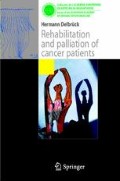Abstract
The chief aim of all medical, potentially curative follow-up care measures (recurrence prophylaxis, early detection and therapy of disease recurrence) is to lengthen survival time (fig. 1.3). The actual tumour illness thus represents the focus of curative follow-up care.
Access this chapter
Tax calculation will be finalised at checkout
Purchases are for personal use only
Preview
Unable to display preview. Download preview PDF.
Bibliography
— Alguacil J, Pollan M, Gustavsson P (2003) Occupations with increased risk of pancreatic cancer in the Swedish population. Occup Environ Med 60,8: 570–6
— Aspinal F, Hughes R, Higginson I et al. (2002) A user’s guide to the palliative care outcome scale. Palliative care & policy publications. Kings College, London
— Barat M, Franchignoni F (2004) Assessment in physical medicine and rehabilitation. Maugeri Foundation Books, PI-ME Press Pavia
— Bergasa NV (2006) Medical palliation of the jaundiced patient with pruritus. Gastroenterol Clin North Am 35,1: 113
— Bausewein C, Fegg M, Radbruch L et al. (2005) Validation and clinical application of the German version of the palliative care outcome. J Pain Symptom Manage 30: 51–62
— Bundesarbeitsgemeinschaft für Rehabilitation (BAR) (2003) Rahmenempfehlungen zur ambulanten onkologischen Rehabilitation. Schriftenreihe der Bundesarbeitsgemeinschaft für Rehabilitation. Frankfurt
— Cella D (1997) The (Fact-An) scale: A new tool for the assessment of outcomes in cancer anemia and fatigue. Semin Hematol 34(suppl 2): 13–9
— Delbrück H (2002) Bauchspeicheldrüsenkrebs. Rat und Hilfe für Betroffene und Angehörige. Kohlhammer, Stuttgart
— Delbrück H, Haupt E (edit.) (1998) Rehabilitationsmedizin. Ambulant — Teilstationär — Stationär. Urban & Schwarzenberg, München
— Delbrück H (2004) Krebsschmerz. Rat und Hilfe für Betroffene und Angehörige. Verlag W Kohlhammer, Stuttgart
— Dunn GP (2002) Surgical palliation in advanced disease: Recent developments. Current science 4: 233–41
— EAPC Expert Working Group (2001) Morphine and alternative opioids in cancer pain. The EAPC recommendation BJC 84: 587
— Epelbaum R, Rosenblatt E, Nasrallah S et al. (2002) Phase II study of gemcitabine combined with radiation therapy in patients with localized, unresectable pancreatic cancer. J Surg Oncol 81: 138–43
— Glimelius B et al. (1996) Chemotherapy improves survival and quality of life in advanced pancreatic and biliary cancer. Ann oncol 7: 593
— Gordon JN, Trebble T, Ellis RD et al. (2005) Thalidomide in the treatment of cancer cachexia: a randomized placebo controlled trial. GUT, 54: 540–5
— Hocht S, Wiegel T, Siegmann A et al. (2004) Radiochemotherapy in unresectable pancreatic cancer. Front Radiat Ther Oncol 38: 87–93
— Holt A, Patel M, Ahmed MM (2004) Palliation of patients with malignant gastroduodenal obstruction with self-expanding metallic stents: The treatment of choice.
— Jatoi A, Windschitl HE, Loprinzi CL et al. (2002) Dronabinol versus megestrol acetate versus combination therapy for cancer-associated anorexia. J Clin Oncol 20: 567–73
— Koski S, Venner P (2000) Chemotherapy-induced nausea and vomiting. In: Nabholtz JM Tonkin K, Aaapro MS et al. (edit) Breast cancer Management. Application of evidence to patient care. M Dunitz London 317–29
— Levy MH, Cohen SD (2005) Sedation for the relief of refractory symptoms in the imminently dying: A fine intentional line. Semin Oncol 32: 237–46
— Maguire P, Pitceathly C (2002) Key communication skills and how to acquire them. BMJ 325: 697–700
— McLeod RS (1999) Quality of life, nutritional status and gastrointestinal hormone profile following Whipple procedure. Ann Oncol 4(suppl): 281–5
— Monti D, Yang J (2005) Complementary medicine in chronic cancer care. Semin Oncol 32: 225–31
— Moore M, Goldstein D, Hamm J et al. (2007) Erlotinib plus Gemcitabine compared with Gemcitabine alone in patients with advanced pancreatic cancer. J clin Oncol 25,15: 1960–6
— Neoptolemos J, Cunningham D et al. (2003) Adjuvant therapy in pancreatic cancer: Historical and current perspectives. Annals of Oncology 14: 675–92
— Oyan N (2004) Chemoradiotherapy for pancreatic cancer: Current status and perspectives. Int J Clin Oncol 9,6: 451–7
— Ogata Y, Hishinuma S (2002) The impact of pylorus-preserving pancreatoduodenectomy on surgical treatment for cancer of the pancreatic head. J Hepatobiliary Pancreat Surg 9,2: 223–32
— Patel L, Lindley C (2003) Aprepitant — a novel NK-1receptor antagonist. Expert Opin Pharmacother 4: 2279–96
— Rosemeyer D (1996) After-care rehabilitation after pancreas operations. Z Gastroenterol 34,2: 37–40
— Sanders M, Papachristou G, McGrath K et al. (2007) Endoscopic palliation of pancreatic cancer. Gastroenterol Clin North Am 36,2: 455–76
— Sehlen S, Fahrmüller H, Herschbach P et al. (2003) Psychometrische Eigenschaft des Stress Index Radio Onkologie (SIRO). Strahlenther Onkol 179,4: 261–9
— Sharfman WH, Walsh TD (1990) Has the analgesic efficacy of neurolytic celiac plexus block been demonstrated in pancreatic cancer pain. Pain 41: 267–71
— Sindelar WF, Kinsella TJ (1999) Studies of intraoperative radiotherapy in carcinoma of the pancreas. Ann Oncol 10(suppl. 4): 226–30
— Shah J, Muthusamg VR (2005) Endoscopic palliation of pancreaticobiliary malignancies. Gastrointest Endosc Clin N Am 15,3: 513–31
— Shore S, Vimalachandran D, Raraty MG et al. (2004) Cancer in the elderly: Pancreatic cancer. Surg Oncol 4: 201–10
— Silverman D, Stewart PA, Blair A et al. (2001) Occupational exposure to pesticides and pancreatic cancer. Am J Ind Med 39,1: 92–9
— Smeenk HG, Tran TC, Erdmann J et al. (2004) Survival after surgical management of pancreatic adenocarcinomas: Does curative and radical surgery truly exist? Langenbecks Arch Surg 14
— Tisdale M (2003) Pathogenesis of cancer cachexia. J Support Oncol 1: 159–68
— World Health Organization (1990) Cancer pain relief and palliative care. Technical report, series 804. Geneva
— World Health Organization (2001) International classification of functioning, disabilities and health. www. who.int/classification/icf
Rights and permissions
Copyright information
© 2007 Springer-Verlag France, Paris
About this chapter
Cite this chapter
(2007). Rehabilitation and palliation of patients with pancreatic cancer. In: Rehabilitation and palliation of cancer patients. Collection de L’Académie Européenne de Médecine de Réadaptation. Springer, Paris. https://doi.org/10.1007/978-2-287-72827-3_9
Download citation
DOI: https://doi.org/10.1007/978-2-287-72827-3_9
Publisher Name: Springer, Paris
Print ISBN: 978-2-287-72826-6
Online ISBN: 978-2-287-72827-3
eBook Packages: MedicineMedicine (R0)

